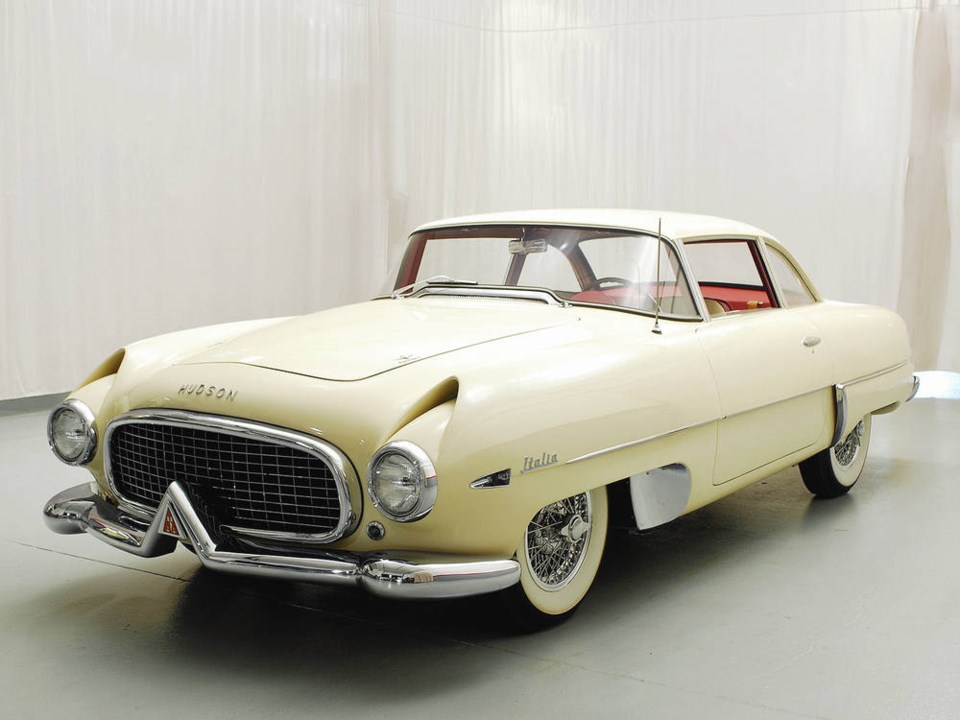The Hudson Motor Car Co. was formed in 1909 with financial backing from Detroit department store owner J.L. Hudson. The company quickly established a reputation for building fast, reliable mid-market cars and survived the 1930s Depression.
During the Second World War, Hudson contributed to military needs with components such as guns, engines and aircraft parts, including many for the Enola Gay B-29 bomber that dropped the first atomic bomb.
After the war, Hudson returned to building cars and light trucks and did well for a few years in the car-starved seller’s market caused by the war-time interruption in car production and low sales during the Depression.
Its new 1948 “Step Down” design was acclaimed, and the low, fast, good-handling Hudson Hornet’s big powerful side-valve six made it king of the stock car tracks during the early 1950s.
But victories on the track were not generating enough orders in the showroom and, despite the new compact 1953 Jet model, Hudson sales shrank almost in half from 1950 to 1953.
Something was needed to rejuvenate Hudson’s image and management decided the answer was a fast, sporty model, perhaps one that could win the famous Carrera Panamericana, better known as the Mexican Road Race. To qualify for the race at least 25 examples had to be built.
Hudson stylists designed a low, futuristic two-door coupe with a sloping hood and one-piece wraparound windshield. Scoops above the headlights directed cool air to the front brakes and slots at the leading edge of the rear fenders cooled the rear brakes. Flow-through cabin ventilation air entered through a cowl vent and exited at the trailing edge of the roof.
The front bumper had a large inverted Vee echoing Hudson’s corporate badge. Rear styling was dominated by three short, fender-mounted horizontal tubes housing the taillights, stoplights and backup lights. Wheels were wire spoke type with knock-off hubs.
Although originally planned for the Hudson Hornet platform, it was shifted to the smaller Hudson Jet’s 105 inch (2,667 mm) wheelbase chassis. Visions of winning the Carrera were abandoned.
Its 183 inch (4648 mm) overall length made it a compact package and the recessed floor contributed to a sleek 54 in. (1372 mm) height. Entry and exit were eased by aircraft-type doors curving into the roof.
Power came from the Jet’s 3.3 litre (201 cu in.), long stroke side-valve 114 horsepower inline six fitted with Hudson’s dual carburetor “Twin-H-Power.” It had a three-speed manual transmission and although the prototype had overdrive, this didn’t survive to production.
Inside, the Italia, as it was called, was handsomely appointed with deep pile carpeting and anatomically designed reclining leather seats (it included some vinyl when production started).
Seat belts were standard, an advanced safety feature for that time, although they were anchored to the seats, not the frame. There was no trunk lid, so cargo space was accessed from inside the cabin.
It was discovered that it would be prohibitively expensive to produce the Italia in low numbers in the United States, so Milan-based coachbuilder Touring was contracted to build a prototype. A Hudson Jet was shipped to Milan, where the body was removed and Touring craftsmen manually created the first Hudson Italia out of aluminum panels over a tubular frame.
Hudson management approved the design and introduced the Italia in the fall of 1953. Letters went to Hudson dealers inviting them to place orders for 1954 delivery.
Response was lukewarm, in part because the Italia’s nearly $5,000 price was several hundred dollars more than a Cadillac coupe. It also lacked the famous Hornet engine that would have given the Italia the performance needed to make it stand out.
Media reaction to the Italia was generally enthusiastic, but the tepid dealer response prompted Hudson to order only 25 more Italias from Touring.
Italia production began in August 1954, but the timing was terrible. A few months earlier on May 1, Hudson and Nash Motor Co. joined to form American Motors Corp. This directed most corporate energy toward integrating the two companies and Italia promotion got lost in all the activity.
AMC production was to be consolidated in Nash’s factory in Kenosha, Wisconsin.
In spite of some Hudson-badged models, Nash designs prevailed in the new company’s cars although the Hudson Hornet engine was carried on for a while. Nash’s successful compact Rambler made the Hudson Jet redundant.
The amalgamation spelt the end for the Italia, although its high price and competition from cars like the Chevrolet Corvette, Kaiser-Darrin and soon to arrive Ford Thunderbird made its future questionable anyway.
A total of 26 Italias — the prototype plus the 25 — were built. Hudson’s attempt to add some Italian cachet failed because it came too late, was priced too high and got lost in corporate activities.



